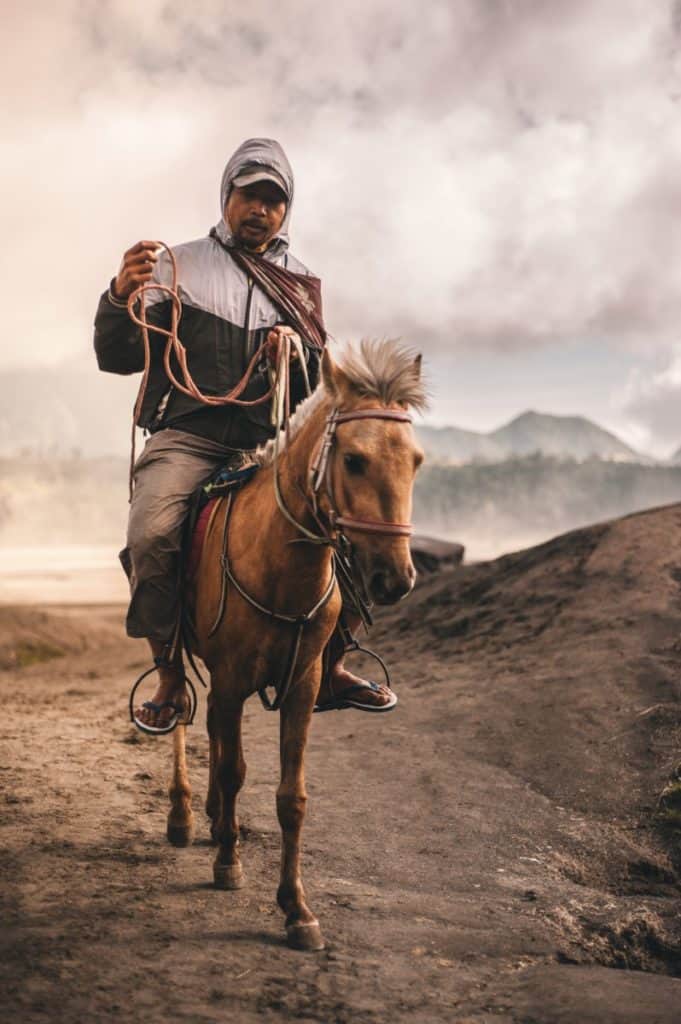
Raise your hand if you have ever been worried about whether you are putting too much strain on a horse’s back? I certainly have, and it is a common concern among riders, especially if you are on the heavier side.
So, is there a weight limit for horseback riding? There is no exact weight limit for horseback riding, but as a general rule, horses should not carry more than 20% of their total body weight. This includes the weight of the tack as well as the rider. How much a horse can carry depends on a range of factors such as height, weight, build and its overall condition.
What is the weight limit for horseback riding?
First of all, thank you for asking this question! Doing so probably means you are concerned with the well-being of horses in general and that you are taking a mature and responsible approach to horse riding.
Although there is no formal weight limit for horseback riding, most reputable equestrian centers and horse riding tour operators will have a set maximum weight for riders. You may see that these can vary a little from establishment to establishment and that is usually because they will all have different types of horses, which impacts the weight they can accommodate. We will come back to this later in the article.
There are many reasons to set a rider weight limit, and although it may for some perhaps come across as discriminatory, this really isn’t the case or the intention. Rider weight limits ultimately exist to ensure the safety of the rider and the well-being of the horse. Let’s talk about why that is.
Potential Negative Effects for the Horse from Carrying Too Heavy
Carrying too heavy can cause a range of issues for a horse and these adverse effects can also occur surprisingly quickly. Some physical issues that could arise are:
- Rub-sores from the saddle being pressed too firmly against the horse’s back
- Sore and strained muscles
- Pinching of nerves due to the added pressure
- Sensitivity/flexibility of the back (the horse drops its back when gentle pressure is placed on each side of its spine)
Most horse owners have a vested interest in keeping their horses in good health and condition. This is particularly important for anyone using a horse for commercial purposes, for instance within the tourism industry. If that horse gets injured this can have a significant negative impact on income.
Potential Dangers for a Rider Who is Too Heavy for His Horse
Rider weight limits are not only there to protect the horse, but it is also in place to keep the rider safe. If a rider mounts a horse not strong enough to carry his weight it may react in negative ways, such as:
- Bucking or rearing in an attempt to remove the rider
- Attempts at biting the mounted rider’s legs to signal discomfort
- Show other signs of irritability and stress
All of these situations can be dangerous and is essentially the horse’s way to object and communicate displeasure. There are also issues beyond the potential reactions a horse can have. If a heavy rider is also inexperienced or unbalanced, this will influence his ability to sit correctly in the saddle and distribute weight evenly as the horse moves, which in turn increases the risk of a fall. A heavy rider has a greater potential for injury when falling from a horse as the impact with the ground will be harder than for a lighter rider.
Another aspect is mounting and dismounting the horse. Heavier riders sometimes find it more difficult to create the momentum needed to push from the ground or mounting block and lift their leg across the horse. This is a problem as it can cause the horse to get stressed and agitated during the mounting process. Also, if a fall occurs on a trail ride, the rider may struggle to get back on without aid.
How Much Weight Can a Horse Carry?

How much a horse can carry depends on a range of factors and the person most equipped to evaluate this is probably its owner or a person that knows the horse well. But in general, the factors that will determine what weight a horse can carry are:
Height and Weight
How large a horse is will obviously impact how much weight it can carry. In general, larger horses can carry more than smaller ones, The weight of the rider, as a general guideline, should not surpass 20% of the total weight of the horse. The weight we refer to here is the ‘normal’ weight of a horse. If it has spent weeks grazing in the fields and comes back fat and heavy, this does not mean it can carry a heavier load (rather the contrary because it is probably not in very good shape after that long holiday!).
The Horse’s Build
Not all horses are created equal. There are hundreds of different horse breeds in the world and although they all have commonalities, they also have different builds. Some are small and stocky with robust legs and short backs like the Icelandic Horse, while others are larger with longer weaker backs such as the Lipizzan. How a horse is built, and especially bone strength and back length will impact its capacity to carry heavy loads. Horses with strong legs and bones as well as medium length backs typically lend themselves better for heavier riders. The reason why a medium back is preferable is that it allows enough space for a saddle that fits a larger rider which can distribute that weight evenly across the horses back and short and robust enough to handle the added pressure.
The Horse’s General Condition
Adding to height, weight, and build is also the horse’s general condition. Just like you, if you have a solid fitness routine and regularly do exercise, you can probably also lift heavier. It’s no different for horses. A toned horse with an overall good exercise regime will be able to take a heavier load on its back than a horse of the same breed and size that has been spending the majority of its time inside the box.
Other Considerations
Beyond the elements pertaining to horse and rider, there are also environmental factors to add to the equation. What type of terrain will you be riding in? It will be significantly easier for the horse to carry someone across a flat surface than across an uneven or steep surface. What gait will go at? Walking will be much lighter than going at a trot or canter. And finally, tack also matters a great deal. In order to correctly distribute the weight across the horse’s back, it is very important that the saddle fits both horse and rider.
All of these are important considerations when evaluating how much a horse can carry. And consequently, it makes sense that the person or people that know a horse, its attributes, daily routine, and personality will be best placed to make a decision around rider weight limit for that particular mount.
How Can I Know if a Horse Can Carry Me?
Beyond the 20% guidelines, there is no hard and fast rule to figure this out. However, go-horse has a great calculator that lets you enter your weight, your horse’s weight, plus the weight of your tack to find out if you fall within the 20% weight range. If you don’t know how much your horse weighs, they also have a calculator to figure that out!
What Kind of Horse Can Carry a Heavy Rider?

There are many horse breeds that are better suited to heavier riders. As mentioned before, what they typically have in common is strong bones and medium length backs. These are a few popular picks for stronger horse breeds.
- Percheron
- Westphalian
- Irish Draft
- Belgian Draft
- Spanish-Norman
- Clyesdale
- Friesian
We know weight can be a contentious subject and the aim of this article is in no way to ‘fat shame’ anyone, but to provide insight as to what capacities horses generally have and what aspects are important to consider if you are a heavier rider. Finally, let’s also remember that this is not just about ‘the extra kilos or pounds’. A muscular man can weigh just as much or more than a woman that falls into the overweight category and it is not uncommon for riders to fall outside the 20% range.
This article is accurate and true to the best of the author’s knowledge. It is not meant to substitute diagnosis, prognosis, treatment or any type of medical advice for humans or horses. Animals exhibiting signs and symptoms of distress should be seen by a veterinarian immediately.


